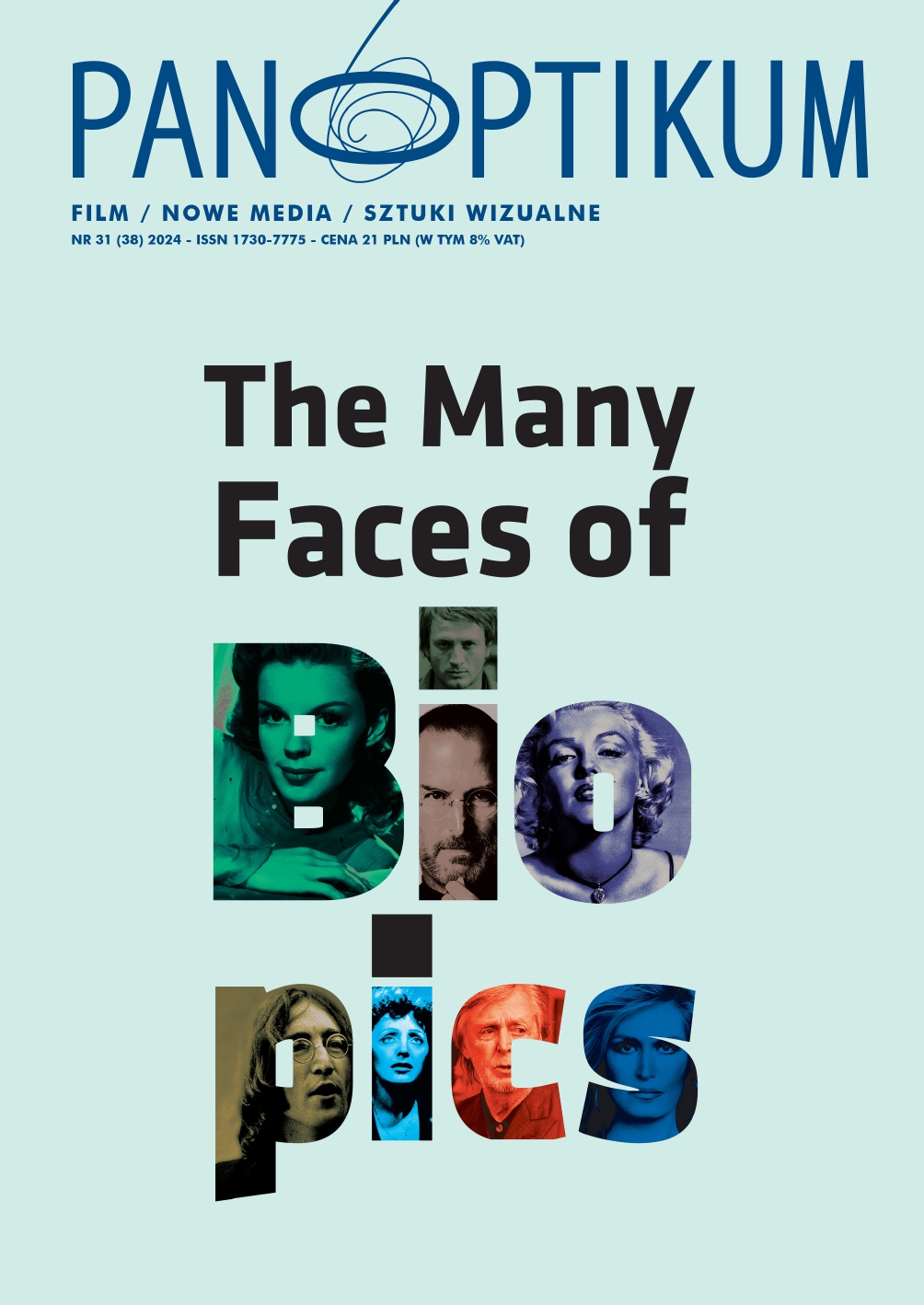Biopics of Female Hollywood Stars Speak to #MeToo Era: The Case of Judy (2019) and Blonde (2022)
DOI:
https://doi.org/10.26881/pan.2024.31.03Słowa kluczowe:
Female biopics, Hollywood Golden Era, Judy Garland, Marilyn Monroe, Stardom, #MeToAbstrakt
This article analyzes two recent biopics, Judy (2019, Rupert Goold) and Blonde (2022, Andrew Dominik), which reimagine the icons from the Hollywood Golden Era, Judy Garland and Marilyn Monroe respectively, under the prism of the #MeToo movement. By examining the way in which these movies treat abusive experiences within the film industry, along with their placement in the public arena, this paper exposes how contemporary biopics dedicated to female movie stars face the consequences of #MeToo in Hollywood.
In terms of textual construction, both movies presumptively adopt a female perspective in portraying actresses’ experiences of exploitation –such as sexual harassment, eating disorders, substance abuse, and more– under a male-dominated Hollywood studio system. Meanwhile, directors’ articulated intentions, promotional campaigns, reviews, and film critiques seeking to convincingly place the films in the domain of public discussion around #MeToo.
Despite this ‘feminist’ assumption, this article will argue that these movies, while appearing to confront and re-address injustices in Hollywood through revisiting the mythical narratives of well-known female stars, fail to challenge the melodramatic victimization plot familiar in traditional biopics about women. In doing so, it will explore how they reinforce a representation of the female Hollywood star after #MeToo as a mentally troubled woman struggling to survive in an exploitative film industry.
Downloads
Bibliografia
Banet-Weiser, S., Gill, R., and Rottenberg, C. (2019). Postfeminism, Popular Feminism and Neoliberal Feminism? Sarah Banet-Weiser, Rosalind Gill and Catherine Rottenberg in Conversation. Feminist Theory, 21(1): pp. 3-24.
Barris, G. and Steinem, G. (1986). Marilyn. Text by Gloria Steinem and Photographs by George Barris, New York: Henry Holt and Company.
Bingham, D. (2013). Whose lives are they anyway? The biopic as contemporary film genre, London: Rutgers University Press.
Boyle, K. (2019). #MeToo, Weinstein and Feminism, Glasgow: Palgrave MacMillan.
Bowness, G. (2019). ‘Judy’ biopic speaks to the #MeToo era. Xtramagazine, 27 September. Available at: https://xtramagazine.com/culture/judy-biopic-speaks-to-themetoo-era-162637 [Accessed February 20, 2024].
Brown, T. and Vidal, B. (eds.) (2014). The Biopic in Contemporary Film Culture, New York and London: Routledge.
Cartmell, D. and Polascheck, A. D. (eds.) (2020). A Companion to the Biopic, Hoboken: John Wiley and Sons.
Clarke, G. (2000). Get Happy. The Life of Judy Garland, New York: Delta Trade Paperbacks.
Carol Oates, J. (2001). Blonde, London: 4th Estate.
Cohan, S. (2019). Hollywood by Hollywood. The Backstudio Picture and the Mystique of Making Movies, New York: Oxford University Press.
Custen, G. F. (1992). Bio/Pics. How Hollywood Constructed Public History, New Brunswick, NJ: Rutgers University Press.
Dyer, R. (2006). Heavenly Bodies. Film stars and society, London & New York: Routledge.(1991). A Star is Born and the Construction of Authenticity, in. C. Gledhill, ed. Stardom: Industry of Desire. London & New York: Routledge.
Dominique, R. (ed.) (2010). Rape in Art Cinema, New York: Bloomsbury.
Ebiri, B. (2022). Lessons from Filming Nick Cave’s Journey Through Grief. Vulture, 11 May. Available at: https://www.vulture.com/2022/05/andrew-dominik-on-blondeand-filming-nick-caves-grief.html [Accessed February 26, 2024].
Harrison, R. (2019). How Biopic ‘Judy’ Silences Garland. And Why That Matters to Survivors. Screen Queens, 4 October. Available at: https://screen-queens. com/2019/10/04/how-biopic-judy-silences-garland-and-why-that-matters-for-survivors/ [Accessed February 20, 2024].
Hollinger, K. (2020). Biopics of Women, London and New York: Routledge.
Kantor, J. and Twohey, M. (2017). Harvey Weinstein Paid Off Sexual Harassment Accusers for Decades. The New York Times, 5 October. Available at: https://www. nytimes.com/2017/10/05/us/harvey-weinstein-harassment-allegations.html [Accessed February 20, 2024].
Lodge, G. (2019). Film Review: Renée Zellweger in ‘Judy’. Variety, 30 August. Available at: https://variety.com/2019/film/reviews/judy-review-renee-zellweger-1203316871/ [Accessed February 20, 2024].
Löwenthal, L. (1944). Biographies in Popular Magazines. In P. F. Lazarsfeld and F. Stanton, eds. Radio research, 1942–43 (pp. 507–548), New York: Duell, Sloan, & Pearce.
McLean, A. (2002). Feeling and the Filmed Body: Judy Garland and the Kinesics of Suffering. Film Quarterly, 55(3), pp. 2-15.
Newland, C. (2022). ‘I’m not Interested in Reality, I’m Interested in Images’: Andrew Dominik on ‘Blonde’. Sight and Sound, 27 September. Available at: https://www.bfi.org.uk/sight-and-sound/interviews/im-not-interested-reality-im-interested-imagesandrew-dominik-blonde [Accessed February 21, 2024].
O’Hara, H. (2021). Women vs. Hollywood. The Fall and Rise of Women in Film, London: Robinson.
Pérez, R. (2022). Andrew Dominik says ‘Blonde’ Is About ‘All The Unloved Children Of The World’, Doesn’t Deserve Its NC-17 Rating & More. The Playlist, 11 May. Available at: https://theplaylist.net/andrew-dominik-says-blonde-is-about-all-theunloved-children-of-the-world-doesnt-deserve-its-nc-17-rating-more-20220511/ [Accessed February 20, 2024].
Rosenstone, R. A. (1995). Visions of the Past. Challenge of Film to Our Idea of History, London: Harvard University Press.
Russell, D. (ed.) (2010). Rape in Art Cinema, New York: Bloomsbury.
Tincknell, E. (2022). Tragic Blondes, Hollywood, and the ‘Radical Sixties’ Myth: ‘Seberg’ and ‘Once Upon a Time in Hollywood’ as Revisionist and Reparative Biopic, Celebrity Studies, 14, pp. 568-583.

 Uniwersyteckie Czasopisma Naukowe
Uniwersyteckie Czasopisma Naukowe









